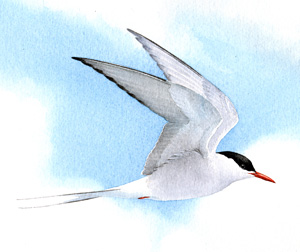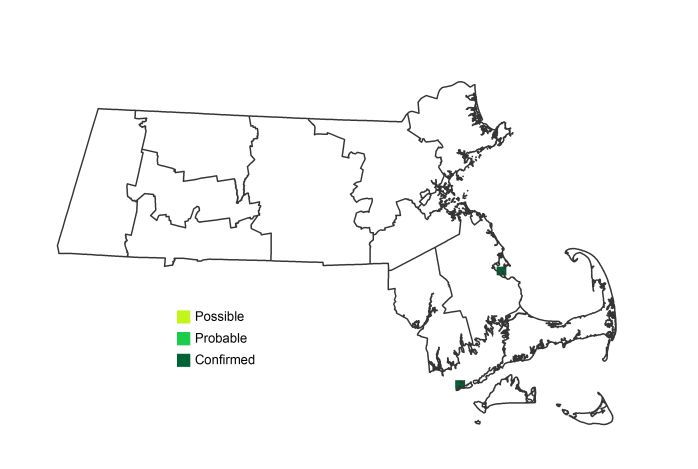Find a Bird
Arctic Tern
Sterna paradisaea

Very local and strongly declining
Conservation action urgent
Species of Special Concern
“Light as a sylph, the Arctic Tern dances through the air above and around you. The graces, one might imagine, had taught it to perform those beautiful gambols which you see it display the moment you approach the spot which it has chosen for its nest.” – John James Audubon, Birds of America
The Arctic Tern may be the world's most celebrated long-distance migrant. Every year, this species flies from its breeding grounds in the Arctic to its wintering grounds in the Antarctic and back, a round-trip of roughly 25,000 miles. This incredible journey allows the Arctic Tern to live in an “endless summer,” and it possibly experiences more hours of daylight every year than any other bird species. Massachusetts represents the southern edge of the breeding range for this feisty species, and those few individuals that breed in the Bay State are state listed as a Species of Special Concern.
Historic Status
As guns blazed on Muskeget Island during the heyday of the millinery trade, the Arctic Tern soon fell prey to fashion. Killed indiscriminately to lend its plumage to ladies’ hats, the species reached near extirpation by the late 1800s, as approximately 40,000 terns of various species were shot on this one island in a single year. By the 1920s, with legal protection standing behind it, the Arctic Tern seemed to be making a comeback. By World War II, 300 to 400 pairs nested on sandy beaches in the state, from Cape Cod to Plymouth to Nomans Land. Unfortunately, the concurrent increase in the numbers of large, predatory gulls soon spelled their impending doom. Undoubtedly, the species benefited from the protection of coastal colonies, but even when spared the depredations of eggers and plume hunters, this species has never been a widespread breeder in Massachusetts.
Atlas 1 Distribution
In Atlas 1, Arctic Terns were found in relatively small numbers amidst Common Terns and Least Terns at large colonies on protected beaches and islands. Plymouth Beach represented the Coastal Plain’s only record, as well as the only one outside the Cape and Islands region. Most of the Arctic Tern’s breeding population was located in 13 occupied blocks, many of which were scattered between Monomoy, Nantucket, Martha’s Vineyard, and the Elizabeth Islands. Additionally, each of these blocks accounted for only a relatively small number of breeding pairs.
Atlas 2 Distribution and Change
The Arctic Tern has currently been reduced to as few as 2 breeding pairs in Massachusetts, 1 of which is a hybrid pair with a Common Tern. While they are not yet completely extirpated from the state, that day is likely drawing very near
Atlas 1 Map

Atlas 2 Map

Atlas Change Map

Ecoregion Data
Atlas 1 | Atlas 2 | Change | ||||||
Ecoregion | # Blocks | % Blocks | % of Range | # Blocks | % Blocks | % of Range | Change in # Blocks | Change in % Blocks |
Taconic Mountains | 0 | 0.0 | 0.0 | 0 | 0.0 | 0.0 | 0 | 0.0 |
Marble Valleys/Housatonic Valley | 0 | 0.0 | 0.0 | 0 | 0.0 | 0.0 | 0 | 0.0 |
Berkshire Highlands | 0 | 0.0 | 0.0 | 0 | 0.0 | 0.0 | 0 | 0.0 |
Lower Berkshire Hills | 0 | 0.0 | 0.0 | 0 | 0.0 | 0.0 | 0 | 0.0 |
Vermont Piedmont | 0 | 0.0 | 0.0 | 0 | 0.0 | 0.0 | 0 | 0.0 |
Berkshire Transition | 0 | 0.0 | 0.0 | 0 | 0.0 | 0.0 | 0 | 0.0 |
Connecticut River Valley | 0 | 0.0 | 0.0 | 0 | 0.0 | 0.0 | 0 | 0.0 |
Worcester Plateau | 0 | 0.0 | 0.0 | 0 | 0.0 | 0.0 | 0 | 0.0 |
Lower Worcester Plateau | 0 | 0.0 | 0.0 | 0 | 0.0 | 0.0 | 0 | 0.0 |
S. New England Coastal Plains and Hills | 1 | 0.4 | 7.1 | 0 | 0.0 | 0.0 | -1 | -0.4 |
Boston Basin | 0 | 0.0 | 0.0 | 0 | 0.0 | 0.0 | 0 | 0.0 |
Bristol and Narragansett Lowlands | 0 | 0.0 | 0.0 | 0 | 0.0 | 0.0 | 0 | 0.0 |
Cape Cod and Islands | 13 | 9.6 | 92.9 | 2 | 1.4 | 100.0 | -10 | -8.3 |
Statewide Total | 14 | 1.4 | 100.0 | 2 | 0.2 | 100.0 | -11 | -1.3 |
Notes
The Natural Heritage & Endangered Species Program of the Massachusetts Division of Fisheries and Wildlife maintains the official counts for this species and other beach nesting birds (see graph below of the number of Arctic Tern pairs since 1985). Our neighbors to the north have had some success with stabilizing this species. For instance, intensive work along the coast of Maine has helped to stabilize that state’s population at about 2,500 pairs on a few islands, and work along the coast of New Hampshire has restored about 14 pairs at the Isles of Shoals. The Arctic Tern has faced a wide array of threats through the years. This species’ loss from Massachusetts, currently the southern terminus of its breeding range, represents a cautionary tale for other species in the future.




